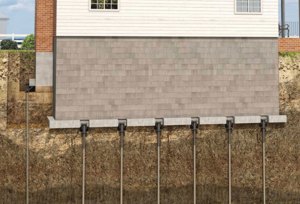Underpinning is used to restore existing foundations when there have been structural failures or extensive damage, using techniques such as mudjacking or using polyurethane material as reinforcement. There are different forms of underpinning available which include using these methods of restrengthening foundations.
Mass Concrete
Traditional mass concrete underpinning is an economical and efficient means of underpinning existing foundations, using controlled excavation until reaching an acceptable bearing stratum, followed by pouring new concrete to transfer load onto this soil layer.
Subsidence can be addressed using this underpinning technique, with one of its most beneficial applications being subsidence repair. Subsideence occurs when a building sinks downward, leading to cracking in walls and floors as it shifts downward. Other symptoms of subsidence may include leaning buildings that slop over onto their sides – in these instances it is essential that advice from an experienced structural repair specialist be sought immediately.
Beam and base underpinning techniques provide more sophisticated underpinning solutions, and one such technique involves the construction of a reinforced concrete beam below, above, or in replacement of an existing footing to transfer load onto mass concrete bases at strategically planned locations. An anti-heave measure may also be included to prevent potential clay soil expansion beneath.
Mass concrete Underpinning Melbourne involves building a concrete beam above or beneath existing foundations to redirect their loads onto it, making this method suitable for conditions in which soil conditions vary widely and access is restricted to foundations.
Mini-Piled
Underpinning through box void excavation involves excavating box-shaped voids to a specified depth beneath existing foundations, before filling them in stages (known as pins) with concrete in order to stabilize existing foundations that show signs of settlement or distress, with professional reports confirming underpinning is required for stability or structural support. It’s generally employed when existing structures exhibit signs of distress such as settlement or distress and require underpinning to keep standing securely.
Piling is an integral component of many construction projects ranging from large building sites to adding basements in homes, and increasingly popular as an underpinning method to help with issues like subsidence or heave. While there are other methods available for strengthening foundations, piling stands out as one of the more cost-efficient solutions due to being installed quickly with little impact to other parts of a building, and without heavy machinery required for installation – saving both costs and disruption for project costs and timelines alike.
Needle Pier
Underpinning is a method used to strengthen the foundations of structures by inserting piers beneath existing ones. It should be employed when foundations of buildings or other structures begin sinking due to moisture intrusion into soil or other factors that reduce bearing capacity of foundations. This strategy should also be utilized when foundations sink due to water seepage in soil or other environmental causes.
Piers are typically constructed out of concrete, constructed by hand-digging pits beneath an existing foundation and filling any voids with it. To protect existing buildings, dry packing material is placed between their foundation and the tops of newly installed piers to prevent damage to either.
Cantilevered piers are sometimes employed to avoid dislocating existing walls during underpinning work. This method is generally preferred when supporting longer sections of wall during underpinning work; additionally, this approach requires less excavations and has a quicker construction process than pit technique.

